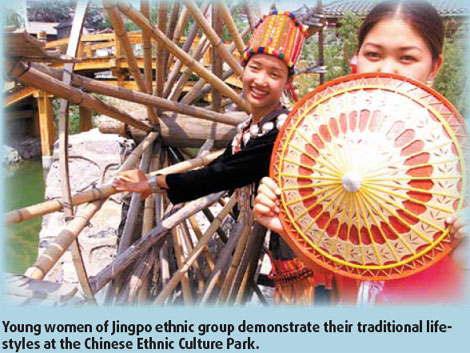Is it possible to walk the length and breadth of China within a single day?
One place you could do just that is at the Chinese Ethnic Culture Park, south of the Bird's Nest and within the Olympic Green.

(Photo: China Daily)
The huge park has been a labor of love and precisely re-creates life in all 56 of China's ethnic groups.
From some of the "mountains" or "plateaus," you can see Beijing's main Olympic venues, as well as the Three Towers of Dali in Yunnan province, vivid replicas of the Jokhang Temple and many other ethnically significant buildings.
The park covers 45 hectares of land within the North Fourth Ring Road and a leisurely stroll throughout will take six or seven hours. It is also an anthropological museum, the China Nationalities Museum.
When construction started in 1992, it was part of China's plan to bid for the 2000 Olympics. China lost the bid in 1993, only to win it eight years later for the 2008 Games.
"It is actually a good thing for us, for we had eight more years to do research work for the museum and collect cultural relics from various ethnic groups," says museum curator Wang Ping.
It took three to five years for the park and museum to prepare the construction of each ethnic group's area. Although the first phase of the park opened back in 1994, work has been going on non-stop ever since.
"I have done fieldwork in all the ethnic minority regions in China - I have never been to some tourist attractions like the Huangshan Mountain or Taishan Mountain but I have been to many villages around the Himalayan Mountains," Wang says.
Every ethnic group has a "village" in the park to display its architecture, religion, lifestyle and cultural relics. Various crops are also planted in accordance with different ethnic groups, including paddy rice for the Dong people, highland barley for the Tibetans and buckwheat for the Yi.
"We hope to encourage visitors to enter the lives of different ethnic groups," says Wang.
Some buildings in the park are original, taken apart at their original spots and then transported to, and reassembled in, Beijing. Others were prepared in the original place and assembled in Beijing.
For example, the symbol of the village of the Salar, a Muslim ethnic group in Northwestern China, is a minaret from the Shangbaizhuang village, Baizhuang township, Xunhua Salar autonomous county, Qinghai province. The minaret was built around 300 years ago, and was moved to the Chinese Ethnic Culture Park in 2003.
In the southern part of the Chinese Ethnic Culture Park, one can visit a replica of the Ermin Tower, an ancient tower in Turpan, Xinjiang Uygur autonomous region. Standing a towering 44 m, it is exactly the same size as the original. The grey-yellow bricks were all made manually in Xinjiang and assembled in Beijing by Uygur craftsmen from Xinjiang.
In the northernmost part of the park, a drum tower, opera stage and "rain and wind bridge" represent the surroundings of a village of the Dong people. A field of paddy rice and ducks and fish in the lake further add to the idyllic atmosphere of the environment.
The park also features live cultural performances. Every morning real lamas from the Tar Monastery of Qinghai province chant Tibetan Buddhist sutras to pray for peace at the Tibetan monastery, while a dongba priest burns incense and says his prayers at the Naxi village.
Then performers of the Miao minority put on a show of "walking on blades", a traditional Miao stunt, while singers and dancers of other ethnic groups such as the Va, Jingpo and Tu entertain visitors with their program in each village.
Throughout the year, festivals of various ethnic groups are celebrated, including the Tibetan Shotan Festival, the Water-sprinkling Festival of the Dai people and the Torches Festival of the Yi.
"Most minority people are very good at singing and dancing. Participating in their activities helps us understand and respect their cultures more," says Lei Feng, a 47-year-old visitor to the park.
Liu Li, a 29-year-old visitor, took part in the "bamboo-pole dance" of the Dai people and found in it a long-lost joy like that of the "skipping elastic band" game in her childhood.
"In the past, I had to travel a long way to experience minority people's lives but now I've found it in Beijing," she says. "Separated only by a wall from the hustle and bustle of the North Fourth Ring Road, it is a totally different world here."
Wang says that after the outer construction of the Chinese Ethnic Culture Park and China Nationalities Museum is complete, they will still have a lot of work to do, especially in improving the presentation of ethnic culture and enriching collections.
The China Nationalities Museum has so far collected about 100,000 cultural relics of various ethnic groups. Especially valuable among them are 5,000 cultural relics of the Qiang people, housed in a typical watch tower. In the recent earthquake in Sichuan, the Beichuan Qiang autonomous county was badly hit and many cultural relics were ruined.
"Had we not collected these cultural relics, they would probably have been lost forever," says Wang.
As an anthropological museum, China Nationalities Museum mainly collects items that reflect ordinary people's lives and on July 15, the museum will open a new exhibition titled Ordinary People's Exhibition - Our History and Our Root, displaying items such as needles, bowls and pouches.
The preface of the exhibition states: "Most of the production tools and daily utensils of the common people arelost without any trace in history. However, it is these articles that give us a vivid picture of our life and culture they tell us about our history and help us find our roots."
"What should we present to the world during the Olympic Games? It's our culture and our people, I believe," says Wang.
(China Daily July 15, 2008)